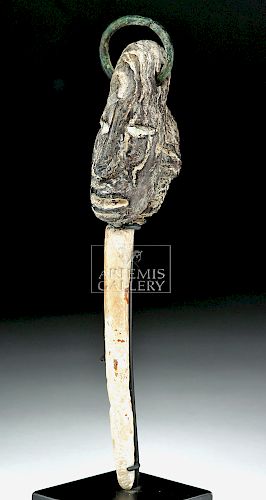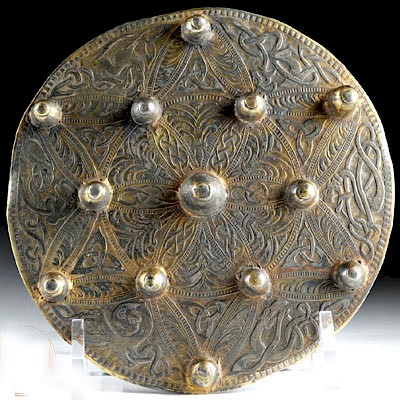Mayan Bloodletting Tool - Wood, Shell, Bone, Copper
Lot 105a
About Seller
Artemis Gallery
686 S Taylor Ave, Ste 106
Louisville, CO 80027
United States
Selling antiquities, ancient and ethnographic art online since 1993, Artemis Gallery specializes in Classical Antiquities (Egyptian, Greek, Roman, Near Eastern), Asian, Pre-Columbian, African / Tribal / Oceanographic art. Our extensive inventory includes pottery, stone, metal, wood, glass and textil...Read more
Estimate:
$8,500 - $12,750
Absentee vs Live bid
Two ways to bid:
- Leave a max absentee bid and the platform will bid on your behalf up to your maximum bid during the live auction.
- Bid live during the auction and your bids will be submitted real-time to the auctioneer.
Bid Increments
| Price | Bid Increment |
|---|---|
| $0 | $25 |
| $300 | $50 |
| $1,000 | $100 |
| $2,000 | $250 |
| $5,000 | $500 |
| $10,000 | $1,000 |
| $20,000 | $2,500 |
| $50,000 | $5,000 |
| $100,000 | $10,000 |
| $200,000 | $20,000 |
About Auction
By Artemis Gallery
Jul 19, 2018
Set Reminder
2018-07-19 10:00:00
2018-07-19 10:00:00
America/New_York
Bidsquare
Bidsquare : Fine Antiquities/Ethnographic Art
https://www.bidsquare.com/auctions/artemis-gallery/fine-antiquities-ethnographic-art-3329
Featuring classical antiquities, ancient and ethnographic art from cultures encompassing the globe, plus fine art. Artemis Gallery info@artemisgallery.com
Featuring classical antiquities, ancient and ethnographic art from cultures encompassing the globe, plus fine art. Artemis Gallery info@artemisgallery.com
- Lot Description
Pre-Columbian, Guatemala and southern Mexico, Maya, Late Classic Period, ca. 700 to 900 CE. An incredible ancient bloodletting instrument, made from a fossilized piece of wood hollowed out and carved into the shape of a head with very classically-Mayan features. The face is dominated by a long nose that projects from the forehead - in fact, we believe that Mayans may have practiced some kind of cosmetic enhancement to get that bump on their forehead at the top of the nose. Iridescent white shell forms the eyes, giving them a blank, staring look. The top of the head is pierced, with a copper ring through them, perhaps so this item could be threaded through a belt or otherwise worn. A needle-like bone, probably made from a large bird bone based on its weight, extends from the underside of the head; it was set into the hollowed out area at the base of the head. Size: 1.75" W x 7" H (4.4 cm x 17.8 cm); 7.25" H (18.4 cm) on included custom stand.
Bloodletting was a ritual practice used throughout ancient Mesoamerica, from the Olmec onward, and the Maya elite seem to have been particular enthusiasts of the practice; it is detailed in countless paintings on ceramics and stone carvings. Archaeologists have found obsidian blade, stingray tails, and bone needles, all believed to have been used in this practice, which allowed an individual to experience a heightened state of consciousness and thus communicate with the gods. The blood given also served as a sacrifice, the price paid by high ranking and royal Mayans in order to contact the supernatural.
Provenance: private Hawaii, USA collection; ex Colin Arundel collection
All items legal to buy/sell under U.S. Statute covering cultural patrimony Code 2600, CHAPTER 14, and are guaranteed to be as described or your money back.
A Certificate of Authenticity will accompany all winning bids.
We ship worldwide and handle all shipping in-house for your convenience.
#132527The wood is in fragile condition. Bone has been reattached at base. Extensive deposits on wood and bone surface. Deep green patina on the copper ring. Bone tip has obviously become blunt over time.Condition
- Shipping Info
-
All shipping is handled in-house for your convenience. Your invoice from Artemis Gallery will include shipping calculation instructions. If in doubt, please inquire BEFORE bidding for estimated shipping costs for individual items.
-
- Buyer's Premium



 EUR
EUR CAD
CAD AUD
AUD GBP
GBP MXN
MXN HKD
HKD CNY
CNY MYR
MYR SEK
SEK SGD
SGD CHF
CHF THB
THB
















